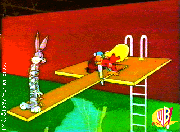 Cartoon Laws of Physics
Cartoon Laws of PhysicsContributed by Trevor Paquette & Lt. Justin D. Baldwin
Are your students tired of those boring old Newton's Laws? These laws correspond to what they are truly expert in: the behavior of falling cartoon characters.
Were I actually trying to use these in a
classroom, I might show students some excerpts from Road Runner, and ask them to write new
laws of their own, and then contrast them to the behavior of real world objects in motion,
and to Newton's Laws.
Cartoon Law I.
Any body suspended in space will remain in space until made aware of its situation.
Daffy Duck steps off a cliff, expecting further pastureland. He loiters in midair,
soliloquizing flippantly, until he chances to look down. At this point, the familiar
principle of 32 feet per second per second takes over.
Cartoon Law II.
Any body in motion will tend to remain in motion until solid matter
intervenes suddenly.
Whether shot from a cannon or in hot pursuit on foot, cartoon characters are so absolute
in their momentum that only a telephone pole or an outsize boulder retards their forward
motion absolutely. Sir Isaac Newton called this sudden termination of motion the stooge's
surcease.
Cartoon Law III.
Any body passing through solid matter will leave a perforation conforming to its
perimeter.
Also called the silhouette of passage, this phenomenon is the speciality of victims of
directed-pressure explosions and of
reckless cowards who are so eager to escape that they exit directly through the wall of a
house, leaving a cookie-cutout-
perfect hole. The threat of skunks or matrimony often catalyzes this reaction.
Cartoon Law IV.
The time required for an object to fall twenty stories is greater than or equal to the
time it takes for whoever knocked it off the ledge to spiral down twenty flights to
attempt to capture it unbroken.
Such an object is inevitably priceless, the attempt to capture it inevitably unsuccessful.
Cartoon Law V.
All principles of gravity are negated by fear.
Psychic forces are sufficient in most bodies for a shock to propel them directly away from
the earth's surface. A spooky noise or an adversary's signature sound will induce motion
upward, usually to the cradle of a chandelier, a treetop, or the crest of a flagpole. The
feet of a character who is
running or the wheels of a speeding auto need never touch the ground, especially when in
flight.
Cartoon Law VI.
As speed increases, objects can be in several places at once.
This is particularly true of tooth-and-claw fights, in which a character's head may be
glimpsed emerging from the cloud of altercation at several places simultaneously. This
effect is common as well among bodies that are spinning or being throttled. A 'wacky'
character has the option of self-
replication only at manic high speeds and may ricochet off walls to achieve the velocity
required.
Cartoon Law VII.
Certain bodies can pass through solid walls painted to resemble tunnel entrances; others
cannot.
This trompe l'oeil inconsistency has baffled generation, but at least it is known that
whoever paints an entrance on a wall's surface to trick an opponent will be unable to
pursue him into this theoretical space. The painter is flattened against the wall when he
attempts to follow into the painting. This is ultimately a problem of art, not of science.
Cartoon Law VIII.
Any violent rearrangement of feline matter is impermanent.
Cartoon cats possess even more deaths than the traditional nine lives might comfortably
afford. They can be decimated, spliced, splayed, accordion-pleated, spindled, or
disassembled, but they cannot be destroyed. After a few moments of blinking
self pity, they reinflate, elongate, snap back, or solidify.
Corollary: A cat will assume the shape of its container.
Cartoon Law IX.
For every vengeance there is an equal and opposite revengeance.
This is the one law of animated cartoon motion that also applies to the physical world at
large. For that reason, we need the relief of watching it happen to a duck instead.